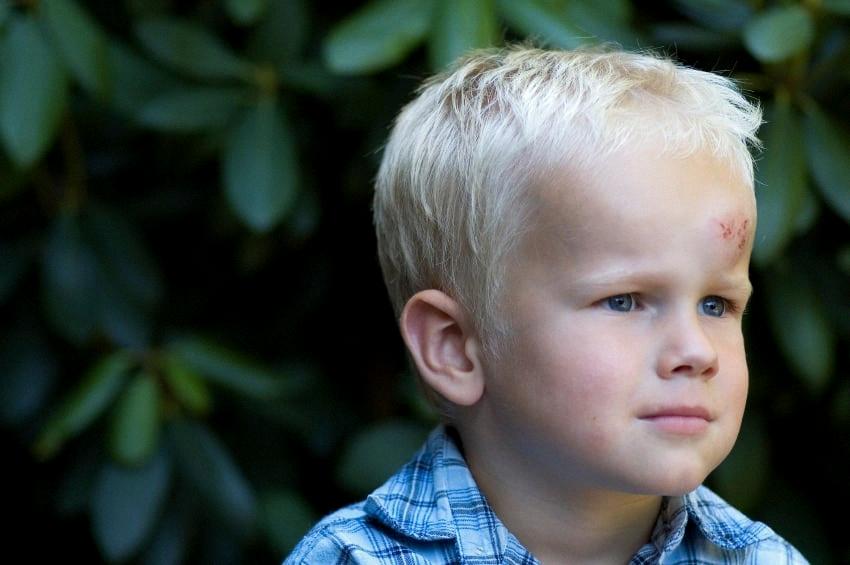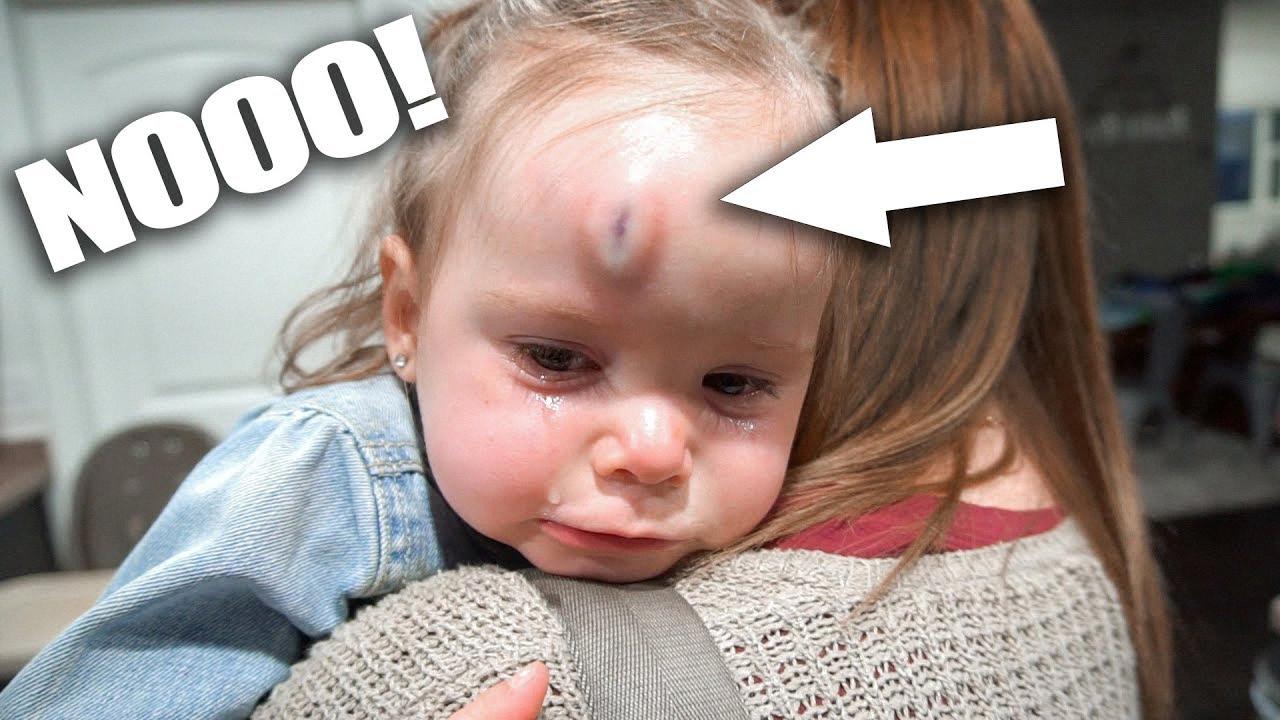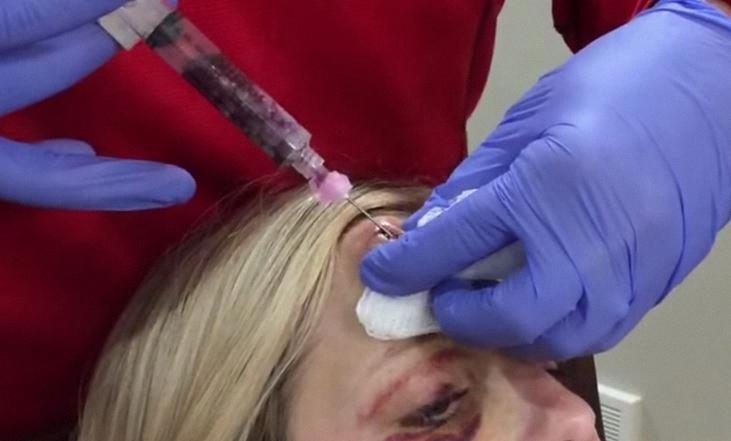A goose egg on the forehead is a common occurrence, especially in children who are prone to falls and accidents. This is a swelling or bump on the forehead that can be quite alarming to parents, but most of the time, it is not a cause for concern. However, in some cases, it can be a sign of a more serios condition, such as a concussion or traumatic brain injury. In this article, we will discuss the causes, symptoms, and treatment of a goose egg on the forehead.
A goose egg on the forehead is caused by trauma to the head, usually from a fall or a blow to the head. When the head is hit, the blood vessels in the scalp can rupture, causing bleeding and swelling. This swelling can lead to the formation of a lump or bump on the forehead, which is often called a goose egg.
The symptoms of a goose egg on the forehead may vary depending on the severity of the injury. In most cases, the bump will be accompanied by pain, redness, and swelling. Other symptoms may include:
– Headache
– Dizziness
– Nausea
– Vomiting
– Loss of consciousness
– Confusion
– Disorientation
– Vision changes
– Severe neck pain
Most of the time, a goose egg on the forehead will resolve on its own without any treatment. However, there are some steps you can take to reduce swelling and alleviate pain:
– Apply ice or a cold pack to the bump for 20 minutes at a time, several times a day.
– Elevate the head to reduce swelling.
– Take over-the-counter pain relievers such as acetaminophen or ibuprofen to relieve pain.
If the injury is more severe, or if there are other symptoms such as loss of consciousness, confusion, or severe neck pain, seek medical attention immediately. A doctor will perform a physical exam and may order imaging tests such as a CT scan or an MRI to assess for more serious injuries.
The best way to prevent a goose egg on the forehead is to take steps to prevent head injuries. This includes:
– Wearing a helmet when riding a bike or participating in contact sports.
– Installing safety gates and window guards in your home to prevent falls.
– Using non-slip mats in the bathroom and shower.
– Removing tripping hazards such as loose rugs and cords.
– Supervising children when they are playing or climbing.
A goose egg on the forehead is a common occurrence that is usually not a cause for concern. However, if the injury is severe or accompanied by other symptoms, seek medical attention immediately. By taking steps to prevent head injuries, you can reduce your risk of developing a goose egg on the forehead.
When Is It Necessary to Seek Medical Attention for a Goose Egg on the Forehead?
A goose egg on the forehead is a common occurrence, especially in children. It is usually caused by a blow or bump to the head, which results in the swelling of the soft tissue uner the skin. In most cases, a goose egg is not a cause for concern, and it will go away on its own in a few days. However, there are certain situations when you should worry about a goose egg on the forehead.
The first and most obvious situation is when the injury is severe enough to cause unconsciousness, confusion, or disorientation. If you or someone you know experiences any of these symptoms after a head blow, it is crucial to seek medical attention immediately. This could be a sign of a concussion, which is a type of traumatic brain injury that requires prompt medical treatment.
Another situation when you should worry about a goose egg on the forehead is when it is accompanied by other symptoms such as vomiting, dizziness, vision problems, or severe headache. These symptoms could be a sign of a more severe brain injury, and it is essential to seek medical attention right away.
If the goose egg on the forehead is very large, or if it continues to grow, you should also seek medical attention. This could be a sign of a more severe injury, such as a skull fracture or bleeding inside the brain.
A goose egg on the forehead is usually not a cause for concern, and it will go away on its own in a few days. However, if you or someone you know experiences any of the symptoms mentioned above, it is essential to seek medical attention immediately.

Source: todaysparent.com
Treating a Goose Egg on the Forehead
A goose egg on the forehead is a common injury, especially among children. It occurs when blood or oher fluids collect under the scalp due to an impact to the head. While it may look alarming, it is usually not a serious injury and can be treated at home. Here are some steps to follow:
1. Apply ice or cold packs: The first thing to do is to apply ice or cold packs to the affected area. This will help reduce swelling and pain. You can wrap the ice or cold pack in a towel and apply it to the affected area for 20 minutes at a time, several times a day.
2. Check for other injuries: It’s essential to check for other injuries, especially if the goose egg is the result of a fall or other accident. See if there are any cuts or bruises on the face or head. If so, seek medical attention immediately.
3. Rest: Rest is essential to help the body heal. Make sure to rest and avoid any strenuous activities that could cause further injury.
4. Pain relief: Over-the-counter pain relief medications such as acetaminophen or ibuprofen can be used to help manage pain.
5. Watch for any changes: Keep an eye on the goose egg and watch for any changes in size, color, or shape. Seek medical attention if there are any concerns.
6. Seek medical attention if necessary: If the goose egg is large, accompanied by severe pain or other symptoms such as dizziness, confusion, or loss of consciousness, seek medical attention immediately.
A goose egg on the forehead can be treated at home with ice, rest, and pain relief. However, it’s essential to watch for any changes and seek medical attention if necessary.
The Risks of a Goose Egg on the Head
A goose egg on the head is a common occurrence, especially in children. This refers to an oval-shaped protrusion on the scalp caused by trauma to the skin and broken blood vessels. It is not a cause for immediate concern and typically resolves on its own over time.
It is important to note that while goose eggs may look alarming, they are generally not a cause for worry. The swelling may be accompanied by pain and tenderness, but this should also subside with time.
If your child has a goose egg, it is recommended to monitor them closely for any signs of a concussion, such as dizziness, confusion, or loss of consciousness. If any of tese symptoms occur, seek medical attention immediately.
To alleviate discomfort, you can apply a cold compress to the affected area for 20 minutes at a time, several times a day. Over-the-counter pain relievers may also be used as directed.
While a goose egg on the head may look concerning, it is a common and typically harmless occurrence. However, closely monitor your child for any signs of a concussion and seek medical attention if necessary.
Signs of a Serious Bump on the Forehead
A bump on the forehead can vary in severity depending on the cause and symptoms that accompany it. In most cases, a small, painful bump on the forehead is not serious and will resolve on its own. However, if the bump is accompanied by oter symptoms, it may require medical evaluation.
If the bump is the result of a head injury and is accompanied by severe headache, loss of consciousness, repeated vomiting, vision changes, or severe neck pain, it is important to seek medical attention immediately. These symptoms may indicate a more serious head injury, such as a concussion or skull fracture, and require urgent medical care.
Other factors that may indicate a more serious bump on the forehead include:
– Age: Infants, young children, and older adults are at a higher risk of complications from head injuries.
– Cause: If the bump is the result of a fall from a significant height, a car accident, or other traumatic event, it may be more serious.
– Location: Bumps that occur near the eyes, nose, or mouth may require medical evaluation to ensure there is no damage to these areas.
In general, if you are unsure about the severity of a bump on the forehead, it is best to seek medical advice to ensure proper evaluation and treatment.
How Long Does It Take for a Goose Egg to Hatch?
A goose egg, also known as a bump on the head, is a common injury that can occur due to a blow or impact to the head. The swelling that results from this injury can vary in size and severity, and there may be a range of symptoms associated with it.
In general, a goose egg can take anywhere from a few days to several weeks to go down. This will depend on the severity of the injury and the individual’s overall health and healing ability. However, it is important to note that a bigger bump does not necessarily indicate a more seious injury. Minor injuries can result in large bumps, while more serious injuries may not result in noticeable swelling.
To help reduce swelling and promote healing, it is important to take proper care of the injury. This may include applying ice or a cold compress to the affected area, resting and avoiding physical activity that could exacerbate the injury, and taking over-the-counter pain medication as needed. It is also important to monitor the injury closely and seek medical attention if symptoms worsen or do not improve over time.
The length of time it takes for a goose egg to go down can vary widely depending on the severity of the injury and the individual’s healing ability. Proper care and attention to the injury can help promote healing and reduce swelling over time.

Source: youtube.com
When to Seek Medical Attention for a Head Bump
Head bumps are common among people of all ages. Though most head bumps are not serious, some may require medical attention. It’s essential to know when to get a head bump checked to avoid any potential complications.
If you or your child experiences a knock to the head, it’s essential to keep a close eye on any symptoms that may arise. Seek immediate medical attention if you notice any of the following signs:
– Unconsciousness, either briefly or for a more extended period.
– Difficulty staying awake or still being sleepy several hours afer the injury.
– Severe headache that doesn’t go away with over-the-counter pain medication.
– Prolonged nausea or vomiting.
– Slurred speech or difficulty in communicating.
– Weakness or numbness in the arms or legs.
– Unequal pupil size or unresponsive pupils.
– Seizures or convulsions.
– Clear fluid draining from the ears or nose.
– Vision disturbances, such as blurred vision or double vision.
If you experience any of these symptoms after a head bump, it’s essential to seek immediate medical attention. A doctor will assess the severity of the injury and provide necessary treatment.
Remember, head injuries can be severe, and symptoms may not appear right away. It’s crucial to keep a close eye on any symptoms that may arise in the hours or days following a head bump. If in doubt, always seek medical attention to ensure your safety and well-being.
The Benefits and Risks of Applying Ice to a Goose Egg
If your child has bumped their head and developed a goose egg or swelling, it is recommended to apply ice to the affected area. Ice can help to ease the pain and reduce swelling. However, it is important to keep a cloth or towel between the ice pack and your child’s skin to avoid any potential skin damage.
It is recommended to apply ice for no longer than 15 to 20 minutes at a time. After a break, you can re-apply the ice if necessary. It is also important to note that if your child has a head injury or if the bump is severe, you should seek medical attention immediately.
Applying ice to a goose egg can help to reduce swelling and ease pain, but it should be done with caution and for a limited amount of time. If the bump is severe or if your child has a head injury, seek medical attention riht away.
Treating a Swollen Forehead After a Fall
A swollen forehead after a fall can be a painful and uncomfortable experience. However, there are several steps you can take to alleviate the swelling and promote healing.
1. Rest: One of the most important thigs you can do after a fall is to rest. This will allow your body to recover and reduce swelling.
2. Cold Compress: Applying a cold compress to the swollen area can help reduce swelling and inflammation. You can do this by wrapping a bag of ice or a cold pack in a towel and holding it against the swollen area for 20 minutes at a time.
3. Elevate the Head: Elevating the head can also help reduce swelling. If possible, prop up the head with pillows to keep it elevated.
4. Pain Relief: Over-the-counter pain relief medications such as ibuprofen or acetaminophen can help reduce pain and inflammation.
5. Hydration: Staying hydrated is important for overall health and can help promote healing. Make sure to drink plenty of water and avoid alcohol and caffeine.
6. Seek Medical Attention: If the swelling is severe, there is a lot of pain, or if you experience other symptoms such as dizziness or confusion, seek medical attention immediately.
Rest, cold compress, elevating the head, pain relief, hydration, and seeking medical attention can all help alleviate swelling and promote healing after a fall.
The Effects of Hitting Your Head and Sleep
After sustaining a head injury, it is natural to be concerned about whether it is safe to go to sleep. The good news is that in most cases, it is safe to sleep after hitting your head.
However, it is important to note that in some cases, a head injury can lead to a concussion. In these cases, a doctor may recommend waking the person up every few hours to ensure that their condition has not worsened. This is because a concussion can cause swelling or bleeding in the brain, which can be dangerous if left untreated.
It is also important to pay attention to any symptoms that may develop after a head injury, such as headaches, dizziness, nausea, or confusion. If these symptoms persist or worsen, it is important to seek medical attention right away.
If you are unsure about whether it is safe to go to sleep after hitting your head, it is alays best to err on the side of caution and seek medical attention. A doctor can evaluate your condition and provide personalized recommendations for how to proceed.
While it is generally safe to go to sleep after hitting your head, it is important to be aware of any symptoms that may develop and to seek medical attention if needed.

Can a Goose Egg Result in a Brain Bleed?
A goose egg, which is a lump that forms on the forehead as a result of a blow, is not typically a cause of a brain bleed. The skull is a protective barrier for the brain, and it takes a significant amount of force to cause a traumatic brain injury that results in bleeding. However, if the person is taking blood thinners, even a minor head injury can lead to a brain bleed.
It is important to note that while a goose egg may not directly cause a brain bleed, it is still considered a head injury and should be takn seriously. The person should be monitored for symptoms such as headache, dizziness, confusion, vomiting, and loss of consciousness. If any of these symptoms are present, medical attention should be sought immediately.
Here are some key points to remember:
– A goose egg on the forehead is not typically a cause of a brain bleed.
– The skull provides protection for the brain.
– Blood thinners can increase the risk of a brain bleed from even minor head injuries.
– A head injury, including a goose egg, should be monitored for symptoms and medical attention should be sought if necessary.
The Effects of Bumping Your Forehead
When you bump your forehead, it can result in bleeding under the skin due to the abundant blood supply in this area. This bleeding can cause a hematoma, which is characterized by localized bruising and swelling. In addition to the physical symptoms, a bump to the forehead can also cause pain and tenderness in the affected area.
If the injury is severe enough, it can also lead to a concussion, which is a type of traumatic brain injury. Symptoms of a concussion may include headache, dizziness, confusion, and nausea.
It is important to seek medical attention if you experience any symptoms of a concussion or if the injury appeas to be severe. Treatment may include rest, pain relief medication, and in some cases, surgery.
To prevent bumping your forehead, it is recommended to wear protective headgear, such as a helmet, when participating in activities that carry a risk of head injury. Additionally, avoiding hazardous activities and ensuring a safe environment can also help prevent injuries to the forehead and other areas of the head.
Symptoms of a Slow Brain Bleed
A slow brain bleed, also known as a chronic subdural hematoma, is a serious medical condition that requires prompt attention. Symptoms of a slow brain bleed may not be immediately apparent and can develop gradually over time. Here are some common symptoms to look out for:
– Confusion or disorientation
– Unequal pupil size
– Slurred speech
– Weakness or numbness on one side of the body
– Loss of coordination or balance
– Seizures
– Headache that worsens over time
– Nausea or vomiting
– Difficulty concentrating or remembering things
– Personality changes or mood swings
It’s important to note that these symptoms can also be caused by other medical conditions, so it’s essential to seek medical attention if you experience any of these symptoms. If you or someone you know experiences a head injury or trauma, it’s crucial to seek medical attention immediately, even if there are no immedate symptoms. A slow brain bleed can be life-threatening if left untreated, so it’s essential to get medical help right away.

Source: metro.co.uk
Treating a Bump on the Forehead
When treating a bump on your forehead, it’s important to determine the severity of the injury. If the bump is accompanied by other symptoms such as dizziness, nausea, or vomiting, seek medical attention immediately as it may be a sign of a more serios head injury.
For minor bumps, applying an ice pack or cold compress to the affected area can help reduce swelling and pain. It’s recommended to apply the ice pack for 20 minutes at a time, taking breaks in between to avoid skin damage.
Over-the-counter pain relievers such as acetaminophen or ibuprofen can also help alleviate discomfort. Be sure to follow the recommended dosage on the packaging and consult with a medical professional if you have any concerns.
If the bump is accompanied by a cut or abrasion, clean the area with soap and water and apply an antiseptic ointment to prevent infection. Cover the wound with a sterile bandage until it heals.
In some cases, a bump may develop into a hematoma, which is a collection of blood under the skin. If the hematoma is large or causing discomfort, medical attention may be necessary to drain the fluid.
It’s important to monitor the bump and seek medical attention if it worsens or doesn’t improve within a few days. Taking precautions to prevent head injuries, such as wearing helmets during sports or using caution when walking on slippery surfaces, can help avoid bumps in the future.
The Duration of a Lump After Hitting the Head
Head injuries are a common occurrence that can happen to anyone at any time. These injuries can range from mild to severe, depending on the impact of the blow. When a person receives a head injury, they may develop a lump at the site of the impact. This lump is caused by swelling in the soft tissues of the scalp, and it can be a cause for concern for many individuals.
The duration of the lump after hitting your head depends on the severity of the injury. In most cases, a scalp injury will only cause a mild lump that will clear up within a few days. However, if the injury is severe, the lump may persist for a longer period.
In general, the deep headache that folows a head injury usually clears up within 24 hours. The pain in the scalp at the site of impact may last for up to three days before gradually subsiding. The swelling caused by the injury may take a week to go away completely.
It is important to note that if the lump does not go away after a week or if it becomes more painful, it is advisable to seek medical attention. This could be a sign of a more serious injury, and prompt medical attention could prevent further complications.
The duration of a lump after hitting your head depends on the severity of the injury. Mild injuries will usually clear up within a few days, while more severe injuries may take longer to heal. If in doubt, seek medical attention to ensure that there are no underlying complications.
Conclusion
A goose egg on the forehead is a common occurrence and usually nothng to worry about. It is simply a swelling of the scalp caused by trauma to the skin and broken blood vessels. Applying ice or cold packs can help reduce swelling, but the bump may still be visible for some time. However, it is important to seek medical attention if the head injury is severe and accompanied by symptoms such as loss of consciousness, severe headache, repeated vomiting, vision changes, or severe neck pain. It is better to err on the side of caution and seek medical attention if there are any concerns about the severity of the injury.
